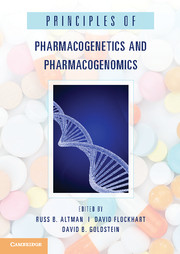Book contents
- Frontmatter
- Contents
- Contributors
- Introduction
- I Critical Concepts
- 1 Introduction to Population Diversity and Genetic Testing
- 2 Genotyping Technologies
- 3 Pharmacokinetics: Absorption, Distribution, Metabolism, Excretion Overview Chapter
- 4 Overview: Adverse Drug Reactions
- 5 PharmGKB, a Centralized Resource for Pharmacogenomic Knowledge and Discovery
- 6 DrugBank
- 7 Ethical Considerations for Pharmacogenomics: Privacy and Confidentiality
- 8 Informed Consent in Pharmacogenomic Research and Treatment
- 9 Legal Trends Driving the Clinical Translation of Pharmacogenomics
- II Therapeutic Areas
- References
1 - Introduction to Population Diversity and Genetic Testing
from I - Critical Concepts
Published online by Cambridge University Press: 05 June 2012
- Frontmatter
- Contents
- Contributors
- Introduction
- I Critical Concepts
- 1 Introduction to Population Diversity and Genetic Testing
- 2 Genotyping Technologies
- 3 Pharmacokinetics: Absorption, Distribution, Metabolism, Excretion Overview Chapter
- 4 Overview: Adverse Drug Reactions
- 5 PharmGKB, a Centralized Resource for Pharmacogenomic Knowledge and Discovery
- 6 DrugBank
- 7 Ethical Considerations for Pharmacogenomics: Privacy and Confidentiality
- 8 Informed Consent in Pharmacogenomic Research and Treatment
- 9 Legal Trends Driving the Clinical Translation of Pharmacogenomics
- II Therapeutic Areas
- References
Summary
Overview of How Genetic Diversity Arises
Genetic diversity arises from differences in the genome of humans. Mapping of the human genome has revealed that humans are approximately 99.9 percent identical relative to their DNA sequences, with differences occurring at the rate of one change in every 100 to 300 bases along the sequence of 3 billion bases that comprise the human genome (1, 2). These differences in coding sequences at these sites are termed single-nucleotide polymorphisms (SNPs) and are considered significant when they occur with a minimum frequency of 1 percent in a given population. Whereas genetic differences of 0.1 percent among individual humans appear negligible, occurrences of ∼10 million SNPs have been cataloged to date. These SNPs may occur in coding or noncoding regions of the genome and may affect gene expression or disease susceptibility. Whereas SNPs are estimated to account for 90 percent of all genetic variability, other genetic differences have been detected and may stem from errors during DNA replication, including copy number variations, insertions, deletions, inversions of bases, or other mutational events caused by environmental factors (3). This genetic variability contributes to genetic diversity among populations as well as its individual members. Genetic diversity has an impact on all manner of human traits from external appearance to disease susceptibility and response to pharmacological agents.
To gain a greater appreciation of the magnitude of the impact that genetic diversity has on human phenotypes, it is best to begin with an exploration of its historical development in modern humans. In general, race and ethnicity, which are largely defined culturally by phenotypic traits or defined by man-made designations of geographic origin, become much less distinct at the genomic level. Mutations can occur within alleles that occupy a distinct site within a given gene or genomic region and thereby help to define traits. It is thought that population genetic diversity is largely due to a combination of allelic mutation at specific sites along the genome and the selective pressure from population segregation that occurred during the migration of humans out of Africa over a period of about 200,000 years (4). Each offspring inherits two alleles, one from each parent. Thus, if either parent is not a carrier of the wild-type allele originally encoded in the genome due to local mutations within the allele, the offspring may inherit the mutant allele and be heterozygous for a given trait. The mutation may be dominant (i.e., expressed), recessive (carried silently), or, in some cases, coexpressed. When a new mutation is associated with a beneficial trait, it is thought that positive selection occurs, allowing those carrying the beneficial allele to survive, reproduce, and pass on the trait to their offspring at a frequency dictated by its pattern of inheritance. However, the major contribution to genetic diversity occurred because of the geographical isolation that resulted from tribal resettlement following migration that produced colonies of individuals with a reduced genetic pool representative of the founders of each new colony.
- Type
- Chapter
- Information
- Principles of Pharmacogenetics and Pharmacogenomics , pp. 3 - 11Publisher: Cambridge University PressPrint publication year: 2012

